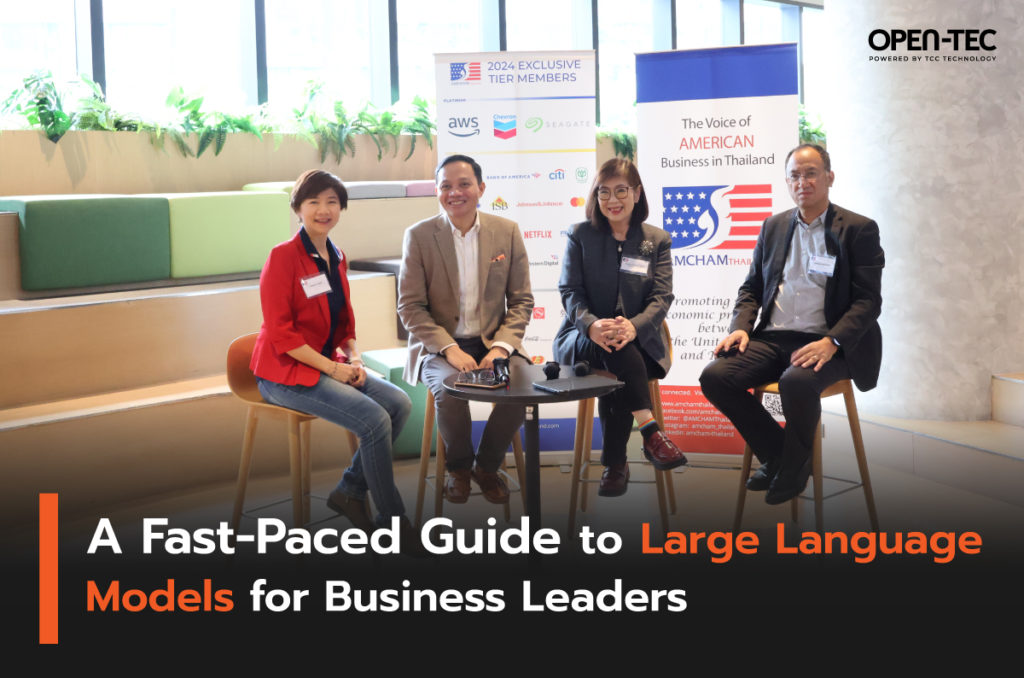Imagine a world where computers can understand not only human language but can also create and communicate nearly as effectively as humans. This is not just a daydream; it’s happening now. Today, OPEN-TEC (Tech Knowledge Sharing Platform), powered by TCC TECHNOLOGY GROUP, has gathered knowledge from the recent event by the AMCHAM Digital Economy Committee, “A Fast-Paced Guide to Large Language Models for Business Leaders.” This event covered several hot topics, including technology behind LLMs, Use Cases, What Works & What Doesn’t Work, and the Future of Work, in various areas including Finance, HR, and Coding. The session was moderated by Waleeporn Sayasit, AMCHAM Digital Economy Committee Co-Chair & GM of TCC Technology. She started the LLMs conversation by stating that “Large Language Models (LLMs), like ChatGPT, Claude, Gemini, were trained on a massive amount of text data. This allows them to generate text & answer our questions in a way that we feel are almost human. LLMs are a type of GenAI, which revolutionizes the way humans interact with technology and unlock a ton of exciting possibilities for the future.”
Demystifying Technology Behind LLMs
LLMs are trained on Internet-scale datasets. These models leverage advanced neural networks and distributed learning techniques to process and understand complex patterns in data, as mentioned by the 1st speaker, Mr. Michael Araneta, AWS Banking Lead in Southeast Asia, Amazon Web Services. He talked about use cases in financial services, like generating advice and recommendations for staff and relationship managers to engage better with customers. LLMs can generate human-like responses and content, suited to the context of the customer. Generative AI (GenAI) plays a foundational role in allowing LLMs to create text, images, and even videos by mimicking human language and creative processes. Additionally, the 2nd speaker, Dr. Thanachart Numnonda, Executive Director IMC Institute, noted that LLMs differ from traditional machine learning models as they are trained on unlabeled data from the Internet. This approach also introduces challenges related to data accuracy and potential biases.
Use Case in Different Areas: How LLMs Can Be Leveraged
In a Human Resource Department LLMs can automate the creation of job descriptions, ensuring consistency and relevance, emphasized the 3rd speaker, Ms. Chutima Sribumrungsart – Independent Board & Advisor – Business & Organization Capabilities, Executive Coach. They can also assist in performance management by analyzing feedback and metrics, and offer personalized career development plans, enhancing employee growth and satisfaction. Moreover, in the area of technology and data, Dr. Thanachart highlighted the role of LLMs as co-workers, aiding in research by quickly processing and summarizing large volumes of information to provide valuable insights.
What Works and What Does Not Work?
LLMs greatly enhance productivity and offer consistent outputs, which is particularly useful in fields like human resources and content creation. However, the accuracy of LLMs depends heavily on the quality of the training
data. Poor-quality data can lead to inaccurate or biased outputs. Ms. Chutima stressed the importance of ethical considerations, especially in ensuring transparency and fairness in the use of AI-generated content.
Increasing Competitive Edge with LLMs
Mr. Michael believes that education and thought leadership are key. Each company intending to use GenAI, and any new technology, for that matter, should be committed to helping staff understand the best uses of LLMs. This can lead to improved customer experiences and operational efficiencies – critical factors for maintaining a competitive edge.
Moreover, in human resources, Ms. Chutima added that LLMs are revolutionizing how teams operate. By automating repetitive tasks, human resource professionals can focus on strategic activities that drive business growth. This shift not only increases efficiency but also enhances employee satisfaction and development.
The Future of Work: Transformations and Opportunities
The impact of LLMs on the future of work is profound. Ms. Chutima discussed how organizations need to prepare their workforce for this technological shift. Training employees and fostering a culture that embraces innovation are essential steps toward a seamless transition. For financial institutions, LLMs can transform client interactions. Mr. Michael highlighted how personalized and efficient customer service experiences, powered by LLMs, can set companies apart in a competitive market. In the fields of data analysis and coding, the opportunities and challenges are equally exciting. Dr. Thanachart noted that LLMs can automate mundane coding tasks, allowing developers to focus on more complex and innovative projects. However, ensuring data quality and providing adequate training remain critical challenges to address.
In conclusion, as business leaders, understanding the technology behind LLMs, leveraging them effectively, and preparing for the impact on the future of work are crucial steps toward harnessing their full potential. The AI revolution of LLMs is at the forefront, promising to reshape our world in ways we are just beginning to imagine. By embracing these technologies businesses can not only stay competitive but also drive innovation and growth in the digital age.
Source: This article was consolidated by AMCHAM Digital Economy Committee. The Committee co-chairs include Nitin Modi, Director of Deloitte Thailand, Lyn Kok, Founder & CEO of Mula-X and Waleeporn Sayasit , GM of TCC Technology
